It’s not unusual to see parents with their babies strapped on their chests these days, and one of the most highly rated baby carriers of this type is the Ergobaby, invented on Maui. For the past six years, inventor Karin Frost has been investing proceeds from her baby carrier’s success in H?k? Nui, a project to create a regenerative community in Upcountry Maui. HPR’s Noe Tanigawa visited H?k? Nui with Kumu Hula Keali‘i Reichel, who is creating a cultural center and home for his h?lau as part of the project.

Kumu Hula Keali‘i Reichel says Kawaiokalena is the first song he wrote for his current home, Pi‘iholo, in verdant upcountry Maui. We’re in Pi‘iholo now, meeting in a clear plastic greenhouse on a gorgeous drizzly morning at H?k? Nui, the 258 acre land project where, on the forested rise behind us, Reichel will build a home for his hula H?lau Ke‘alaokamaile.
Reichel: I’ve lived up here for about 12 year now. I would drive past and take a look and go, wow. Then the Frosts came along and had a vision to re-energize this place. At first I was like, Whoa, how you going do that? But over the years I’ve been watching and one of the best things they ever did was bring the Hewahewa ‘ohana here.

Meet Koa Hewahewa, the Director of Forestry Operations here at H?k? Nui.
Hewahewa: Do what you love, love what you do, has kind of been my mission to find out---and I really love working with the land. That passion, I think, and getting my family involved, my dad, my brother, my whole entire family, my kids, my wahine, we created something special, as far as a family-style operation.
First in Waihe‘e, then expanding their reach, Hewahewa created opportunities to learn about Hawaiian relationship with the land. H?k? Nui Chief Operating Officer Josh Chavez introduced the Hewahewas to the Frost family.
Hewahewa: From there, we came and we thought, Hey, we can do something here, as far as when we look at the mission statement for H?k? Nui, in order to accomplish that, restoring the native flora, fauna, building community, regenerating soil, is kind of right up our alley. We’re pretty good at that.
When the Frost family purchased the 258 acre H?k? Nui property in 2012, it had been in sugar and pineapple production for over 100 years. On their website, acknowledging the indigenous history of the land, H?k? Nui Maui states that as a land management company: “We strive to optimize environmental, social and cultural impacts while operating a financially viable business model, which will sustain itself and expand over time. This we refer to as the Regenerative Quadruple Bottom Line.”

H?k? Nui Chief Operating Officer Josh Chavez: The project is very welcome by the county departments and land use commissions. We’ve all visited them over the years to figure out how to integrate housing with the farm where, you know, we’re using less than 10% of the property for houses. We’re only doing about 22 acres for homes. We’re going to keep 230 acres for overall agriculture use between the farm, forestry, h?lau, and water system, water harvesting. I think it’s a new way hopefully developing can be looked at where you’re not surrounding yourself with a golf course or with concrete everything but you’re actually producing food where you’re living.
Energy will be supplied by largely rooftop solar with batteries and back up generators.
Hewahewa: It’s bigger than us, and I think planting the seeds up here is very, very powerful. There’s no separation. If we can influence our country, our state, our construction unions, everybody who has their hand touching what we’re doing up here, if we can share that natural resources is not disposable, it’s ‘ohana. That we need to revalue all these things. Then we are doing our job, it’s beyond planting trees, it’s planting knowledge that can carry on way beyond after we’re gone.

You’re linking culture and agriculture. That deepens agriculture so much.
Reichel: And it deepens the practices of h?lau, because it gets the dancers into the dirt where all of our power comes from. Every chant that we do, everything we chant about, our pule, all has to do with the forest and with the plants that we chant about. It’s all elemental, that part was separated. Here, for us, it’s a melding.
Reichel: The big goal is to get this statewide. H?lau contribute to the well being of the community, h?lau are a big source of pride, they have huge workforces, it’s not just the dancers, it’s the families that support them and the families that extended that support them and then the community that sees their work. So h?lau is an interesting animal. Can you imagine, one h?lau, or several h?lau in every ahupua‘a, every district, how would that affect the community?
Reichel: H?lau are often very nomadic and yet we are able to put out work that affects the community. If you can have your own space, how much more could you put out?

Hewahewa: What I love about this project, what we’re doing, yeah, we’re fusing generational knowledge with modern techniques. Unlike the days of old, the challenges we face are somewhat different from what our k?puna faced. We do have new threats, we do have new invasive species.
Hewahewa: That’s why I think it so important for this site, and H?lau Kealaokamaile, Kapuau (the H?k? Nui forestry and agriculture base), it’s a great opportunity to share these values that I think were lost and we can still incorporate into corporate structure. Understanding what is our place, what is our role as man, woman, kanaka, and where we belong, where we need to be, and what we can do to contribute---like Keali‘i said, how we going give back.
Reichel: I can tell you, my dancers, every time they pau listen to him talk or they get their hands dirty and stuff, there’s a sense of empowerment, there’s a sense of connectivity I never saw before. In my thirty years of teaching. You can talk the talk, you can talk about the flower, you can talk about the forest, you can talk about the da kine, you can talk about the microbes and stuff but when you actually get down and dirty and get yourself in the dirt, that connectivity transfers into their hula. So now they are not just vessels that are pretty to look at, but these are vessels that are pretty to look at and get something going on inside.

Reichel: That’s the goal.
OHA has committed nearly a quarter million dollars to the project and last week, the USDA promised $598 thousand more to educate Native Hawaiian children about agroforestry as it relates to Hawiian culture. At one point, it was estimated the whole project would cost about $2 million. Ever the optimist, Fred Punahele Krauss, Reichel’s husband and overall enabler, hopes to break ground this summer.





